Soon after the outbreak of the Korean War, the US 1st Marine Tank Battalion was one of the armored units ordered to prepare for a rapid deployment to Korea. Upon arrival, elements of the battalion disembarked at the port of Pusan and immediately went into combat where it was the first unit to engage and defeated the feared T-34 tank. The battalion participated in the amphibious landing at Inchon, the liberation of South Korean capital Seoul and the amphibious landing at Wonsan where it advanced north supporting the Marines at the Chosin reservoir. During the war, there were 15 tank-vs-tank actions that involved the 1st Marine Tank Battalion.

On 25 June 1950, the North Korean Peoples Army (NKPA) spearheaded by ex-Soviet T-34/85 tanks and SU-76M assault guns of the 105th Armored Brigade crossed the 38th Parallel and invaded South Korea. After the capture of Seoul, the NKPA 105th Armored Brigade was raised to division status. Each tank regiment consisted of 3 battalions of 13 tanks (Battalion Commander’s tank and 3 companies of 4 tanks each.) The first digit of the tactical number indicated the Regiment and the following digits were numbered consecutively throughout the regiment.
- 107th Tank Regiment (Numbers 100 to 139)
- 203rd Tank Regiment (Numbers 200 to 239)
- 109th Tank Regiment (Numbers 300 to 339)
On June 27, US President Truman ordered US forces to South Korea. Elements of the US 24th Infantry Division on occupation duty in Japan were airlifted to Korea and M24 Chaffee light tanks based in Japan were hastily sent to Korea. The South Korean (ROK) units and the meager US forces were no match against the invading North Korean armor and infantry units. Throughout the month of July, the UN forces withdrew under pressure and it became known as the “bug out” period. UN air strikes flying from Japan and carriers managed to destroy some of the NKPA armor but it was not enough to stop the invading army. Three M26 Pershing tanks founded in an ordnance depot in Japan were hurriedly rebuilt and sent to Korea. In their first engagement around Chinji on July 28, all three of the Pershing tanks were abandoned after overheating due to incorrect fan belts. The UN forces were pushed all the way down to the southeast corner of the Korean peninsula where a pocket around the port of Pusan was formed and became known as the Pusan Perimeter.
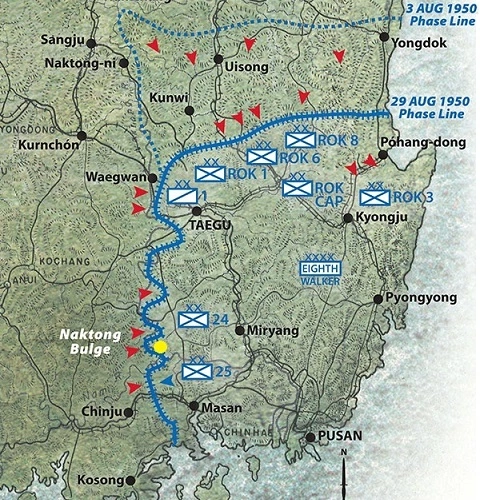
Film: North Korean SU-76 T-34-85 BA-64
The 1st Provisional Marine Brigade of the US Marine Corps (USMC) was an ad hoc unit formed for specific operations and was not considered a permanent USMC unit. The brigade saw five brief activation for service over a 40-year span from 1912 to 1950. The brigade was formed the last time when it was hastily assembled for action in Korea. The organization was a 4,725-man force based around the 5th Marine Regiment and supported by Marine Aircraft Group 33 (MAG-33) including military police, reconnaissance and intelligence companies. The attack force included the 1st, 2nd and 3rd Battalions of the 5th Marine Regiment as well as supporting companies from the 1st Combat Engineer Battalion, 1st Medical Battalion, 1st Motor Transport Battalion, 1st Ordnance Battalion, 1st Service Battalion, 1st Shore Party Battalion, 1st Signal Battalion, 1st Combat Service Group, 1st Amphibian Tractor Company, and the 1st Tank Battalion.
Company A of the the 1st Marine Tank Battalion was activated on July 7 and at the time was equipped with the M4A3(105) intended for infantry support. A request to replace the M4A3s with M26 Pershing tanks was submitted to the Commandant of the Marine Corps and requisitions for spare parts, fording gear and other necessary items were prepared. Approval was received and M26 tanks at a Marine storage depot in Barstow, California were given a thorough mechanical check as time permitted prior to shipment to San Diego for embarkation. Due to the rapid moving situation and limited time for training, two M26 tanks were taken to the tank range at Camp Joseph H. Pendleton. All the gunners and loaders fired only two rounds to familiarize themselves with their new weapon. Very few of them had ever fired the 90mm prior to that time.
At 1345 hours on July 11, all vehicles were loaded aboard beached LSUs, three to a LSU. The LSU was an enlarged version of the WWII built LCT Mk 5s constructed during the late 1940s where the main difference was enlarged crew accommodations. The LSUs transported all the tanks and personnel to the USS Fort Marion LSD-22 (a Casa Grande class dock landing ship) where the LSUs ran into the well deck of the LSD and the operation was accomplished in approximately 3 hours without mishap. If the vehicles were forced to land from the LSUs in much deeper water than necessary or safe, there would be a problem since no time was permitted to waterproof all the vehicles. LSD-22 sailed for Korea on July 12. While en route at 1200 hours on July 13, the forward part of the well deck was flooded to a depth approximately 4 to 5 feet. This resulted in damage to 14 tanks from the salt water and approximately 300 rounds of HVAP ((high-velocity, armor-piercing) 90mm rounds and 5000 rounds of .30 caliber ammunition were soaked. The wet ammunition was thrown overboard by orders from the brigade command. During the remainder of the trip, the tank crews and maintenance men worked long hours repairing the damage that was done in a few minutes. Before, between and during working hours, the men were lectured to, schooled and formed into tank crews. Calisthenics and inspections were the daily routine for the men.
PUSAN
On August 2, the 1st Tank Battalion arrived at the Port of Pusan and commenced debarkation at 2200 hours. By 0900 hours on August 3, all the tanks and equipment have been off-loaded and were standing by to be loaded on rail flat cars for transport to the front lines.
Marine M26s loaded with gasoline, ammunition and rations assemble after unloading at Pusan. LSTs are in the background.

On August 3, 17 M26s, 1 M4A3(105) dozer tank and 1 M32B3 tank retriever were loaded on a rail flat cars in Pusan and transported to Changwon (north of MASAN). Note the crates tied down on the engine deck and the tank tied down on the rail car.
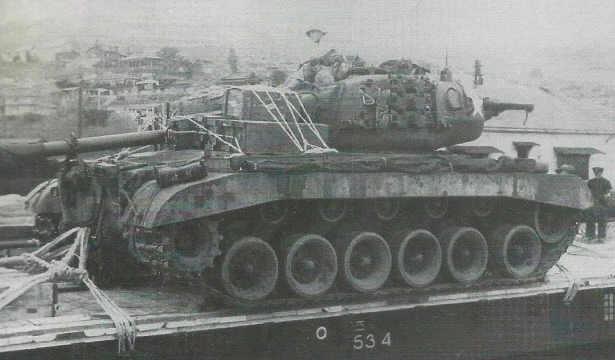
Film: KOREA – BATTLE FOR PUSAN BRIDGEHEAD
A column of other vehicles consisting of 6 International Harvester M-5H-6 2 1/2 ton 6×6 cargo trucks, 3 cargo Jeeps, 3 radio Jeeps,1 Spare parts trailer, 1 Lube trailer and two 300 gallon water trailers road marched to Changwon. All the vehicles arrived at Changwon on August 4. The tanks remained on board the flat cars during the night and at daylight, all the tank guns were bore sighted and two HE (High Explosive) rounds were fired at various targets on the surrounding hillsides.
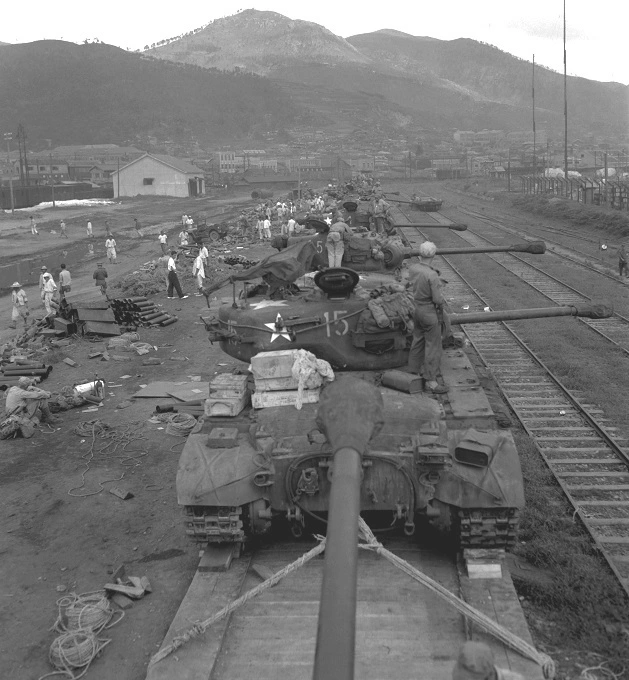
On August 5, the company received orders to offload from the flat cars and proceed to a bivouac area in the vicinity of the railroad and highway junction. Off loading was accomplished with only one tank failed to start due to a dead battery. The tank was started by using a “jump-cable” and it proceeded to the bivouac area. On August 6, one platoon of tanks were attached to the 3rd Battalion, 5th Marines and road marched to the CHINGDONG-NI area. On the road march, tanks numbers 33 and 35 had mechanical problems. Tank 35 was repaired by the platoon maintenance section but tank 33 could not be repaired due to a carburetor problem and was left at a US Army tank park for a day and a half then later rejoined the company on the road march near the station rail head at MASAN.
NAKTONG BULGE
The 1st Provisional Marine Brigade was used as a mobile force which reinforced weak areas or plugged North Korean breakthroughs along the front line. It became known as General Walker’s “Fire Brigade”. The tanks of the Company A, 1st Tank Battalion provided tank support to all the Marine infantry units.
At 1300 hours on August 10, the leading elements of the 2nd Battalion, 5th Marines and portions of D and E companies were pinned down by enemy small arms, automatic weapons, mortars and small direct fire field pieces. Upon arrival to the area, first platoon tanks number 12, 14 and 15 fired at enemy target areas designated by the infantry over the SCR 300 net. As the result of the tank action and other supporting weapons, the infantry were able to continue the advance. Tank number 14 became inoperative due to an electrical power failure and the other two tanks encountered some enemy rearguard action. There was no further tank action that day but around 2000 hours the lead tank number 15 had the road shoulder break away where its right track slipped down and became mired in a rice paddy. Tank number 12 attempted to recover tank 15 but was unable to and then tank 12 became inoperative due to an electrical power failure. Both tanks were disarmed and were retrieved the next day by the M32 tank retriever. At the end of that day, the NKPA were forced to abandon approximately 50 light vehicles and many personal and light crew served weapons.
On August 16, the crew of tank number 14 chow down beside their tank during a break in the fighting. The tactical sign 14 was painted in yellow. The tanks were normally numbered with the company letter followed by the platoon number and the individual tank number but since only company A was deployed, the company letter was omitted.

M26 number 25 had the .50 caliber machine gun relocated in front of the commander’s cupola. From the heights of a ridge, the tank commander is firing at NKPA troops.

The US Marine tanks were the first to defeat the supposedly invincible NKPA T-34/85 tanks. At 2000 hours on August 17, a column of three T-34s with infantry attacked along a road towards the Marine positions on Obong-ni Ridge. US Army infantry on Hill 125 began firing 2.36″ (M9 or M9A1) and 3.5″ (M20) bazookas at the approaching enemy tanks. The Marine infantry began to fire M29 75mm recoil-less rifles at the tanks but the T-34s kept advancing. M26s of third platoon M26s who were at the forward Command Post (CP) at the time in the process of refueling and replenishing ammunition were informed of the attacking T-34s. In a matter of seconds, the M26s were on the road moving to the front line. About 300 yards from the enemy, their advance was halted by trucks parked in the middle of the road and abandoned by the drivers. The tank crewmen drove the trucks off the road allowing their tanks to advance. Before rounding the bend in the road, the platoon leader (2nd lieutenant Granville G. Sweet) gave the order to ready 90mm Armor-Piercing Capped (APC) rounds. Immediately upon rounding the bend, the lead M26 number 34 commanded by Technical Sergeant Cecil Fullerton came face to face with a T-34 (number 322) at a range of 100 yards. Tank 34 fired three rounds of APC, scoring one hit in the turret and two on the front sloped plate which set the T-34 on fire and put it out of action. M26 number 33 commanded by Sergeant Gerald Swinicke was ordered to move into position to the right of Tank 34 which, due the lack of space, placed the tanks hub to hub. It was necessary to have the two tanks in this position to concentrate their fire on the T-34s. The second T-34 came into view at 100 yards and Tanks 33 and 34 fired 1 HVAP and 5 APC at it scoring 1 HVAP hit in the turret and 5 APC hits on the front sloped plate. The hits set the T-34 on fire but because it was still firing against our troops the M26s were ordered to continue firing at it. The two M26s fired 1 HVAP, 2 APC and 4 HE into the right rear side of the turret which blew the turret roof completely off. The third T-34 moved up behind the first and second T-34s at this time and the fire from the two M26s were shifted to it. Five rounds of APC were fired and five hits were made on the front sloped plate. The third T-34 was on fire after the second round hit the sloped plate and after the last hit, it was completely destroyed. After the third T-34 was knocked out, the M26s were ordered to withdraw back to the forward CP. During this engagement, the NKPA tankers were overtly confident, having dominated over US tanks in earlier battles. They probably mistaken the M26s as inferior M24 Chaffees. After this brief engagement, the reputation of US tanks began to rebound. The T-34/85, once dreaded and invincible, was then named the “Caviar Can”.
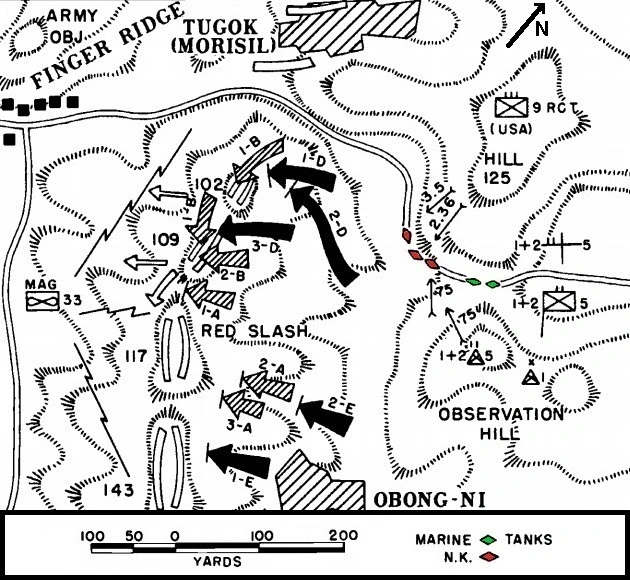
After the engagement, marines advance pass the remnants of the three destroyed T-34s.
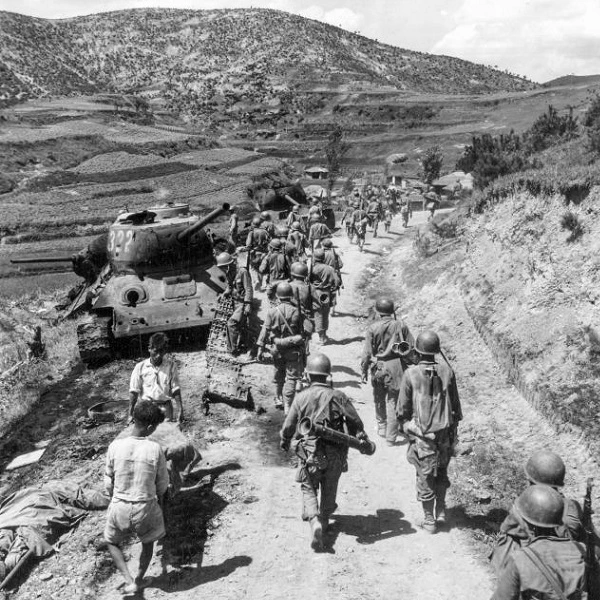
Later, the battalion’s M4A3(105) dozer tank pushes the three destroyed T-34s off the road.
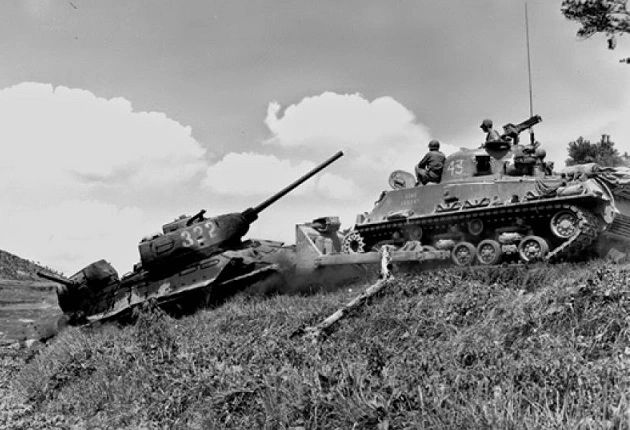
The view of the first and second destroyed T-34s from the other side. The nearest is the second T-34 which suffered a catastrophic internal ammunition fire that blown the turret roof off.

These are views of the T-34 missing its roof revealing its 85mm main gun.

The location of the engagement today was determined with Google Maps.
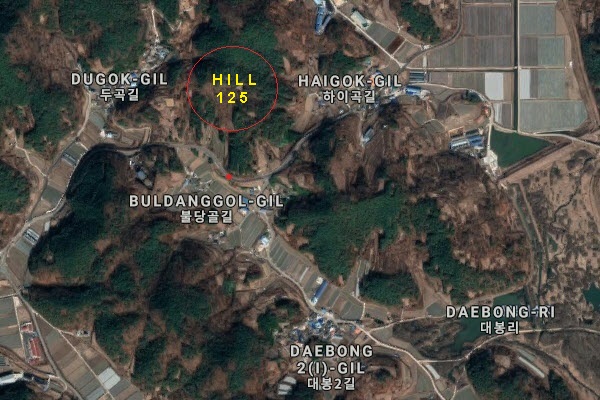
This is the approximate location today. The old windy mountain road was straightened, widened, built up and became a paved highway with guard rails. The trees to the right had grown over the years.
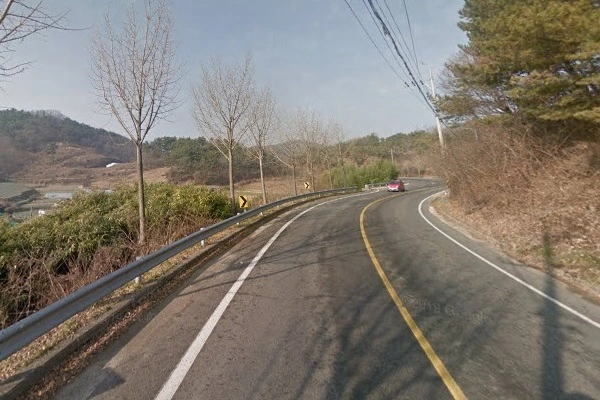
M26 number 33 was marked with three T-34 kill markings on the 440 cfm Rotoclone blower housing located on the front hull between the driver and co-driver hatches. It represents the Marines first success engagement where the once feared T-34 was defeated.

This is another photo of M26 number 33 with the three kill markings accompanying infantry on a road.

Sometime after the three T-34s were destroyed, these M26s are in hull down positions along a ridge road. In the background is the destroyed T-34 of the battalion commander of the 2/109th Tank Regiment number 314. Next to the M26s is an International Harvester M-5H-6 truck.

This is a close up of T-34 number 314 which also had its turret roof blown off due to internal explosions. Obong-ni Ridge is in the background.

This is the other side of T-34 number 314. From the size of the shell holes, it was probably was knocked out by US Army M4A3E8 76mm gun(s).

Film: North Korean Troops T 34/85 destroyed Nakdong River 1950 (Color)
Film: US Army 9th Regiment Command Post, Naktong River, Korea (1950)
This is a line of M26s in front line positions on 2 September. The tank crews had started to add stowage racks along the length of the fenders to store machine gun ammunition cans. This was done due to the heavy consumption of .30 and .50 caliber ammo against NKPA infantry and to resupply difficulties.
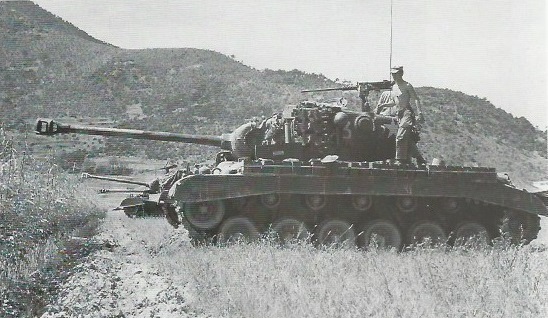
Marine and Army tanks at a forward resupply area near Yongsan on September 3. In the background on the left is a International Harvester M-5H-6 truck with another M26 behind it. A M4A3E8 and two GMC 2 2/12 ton trucks are in the background on the right.
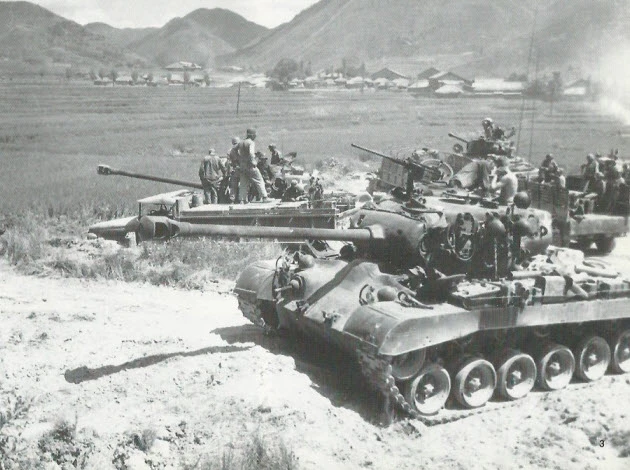
Another view of the same resupply area from another angle. The M26 in the foreground might be tank number 24.
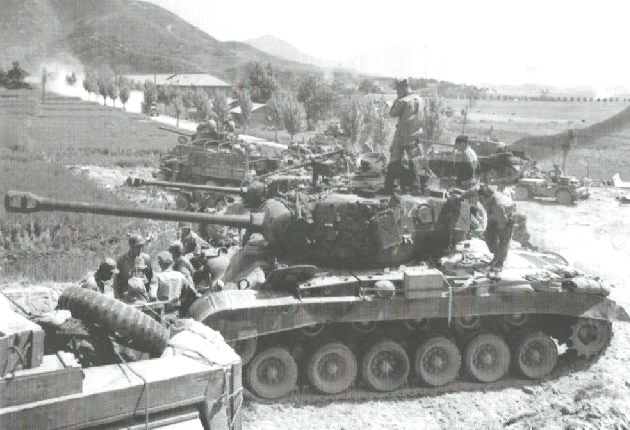
This is another angle. To the right of the M4A3E8 in the background is a bulldozer with another M26 to the right of it.

This is Fullerton’s M26 number 34 perched on a ridge and it has MG ammo cans stored on the fenders. All the M26s in Company A were equipped with the original WWII T81 single pin tracks.
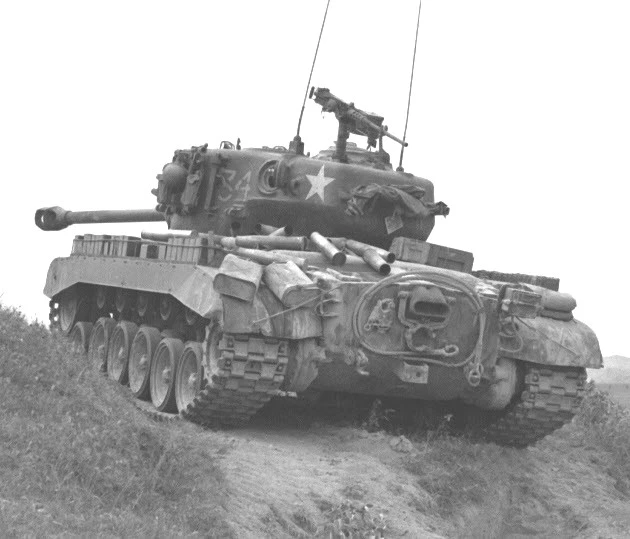
Fullerton’s M26 number 34 advances into Yongsan on September 3.
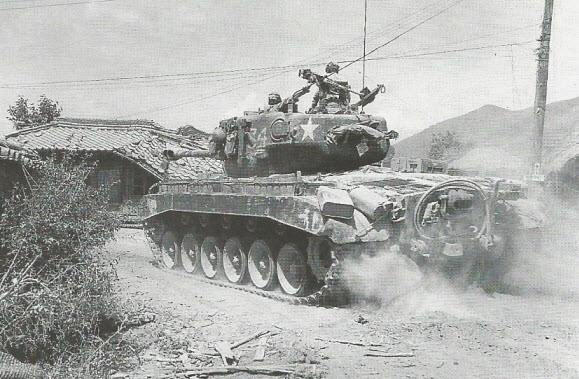
Fullerton’s M26 number 34 was disabled by a mine while clearing a village near Myong-ni around September 3-4. The damage was quickly repaired and the tank was back in action.

Marine M26s knocked out four T-34s west of Yongsan and found a fifth T-34 abandoned. Here are two knocked out T-34s of the NKPA 16th Armored Brigade being inspected by the 5th Marines near Yongsan on September 4.
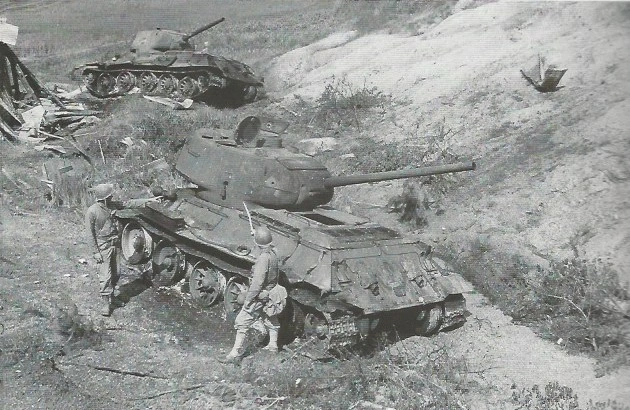
These M26s take are moving up in support of troops in the Obong-ni Ridge area attempting to dislodge NKPA troops. The NKPA were able to hold their positions but were so spent by the heavy fighting they were not able to exploit their gains. The 1st Marine Brigade began withdrawing to the Pusan docks about September 14 for preparations of an amphibious landing.

INCHON, 15 September 1950
Operation Chromite was General Douglas MacArthur’s plan to outflank and break out of the Pusan Perimeter. His plan was to launch a daring risky amphibious assault on the port of Inchon on the west coast of Korea. Inchon was probably one of the worst places in the world for an amphibious assault. The tidal range around Inchon was one of the greatest in the world, varying from an average spring tide range of 27.1 feet to an occasional maximum of 33 feet. The extensive mud flats in the harbor area necessitated a tidal height of 23 feet for landing craft, and 29 feet for LSTs. Only between September 15 to 18 were favorable conditions due to the spring tides, and the next opportunity would not came until the middle of October. When the tide went out, the mud flats would stranded the landing crafts and LSTs for about 11 hours until tide came back in. Two islands, Wolmi-do and So Wolmi-do, located between outer and inner harbors, were linked to each other and to Inchon by causeways and assumed were fortified with harbor defenses requiring them to be secured first before the main assault on Inchon itself. With Inchon being 208 miles (335 km) from Pusan if the North Koreans were able to move superior forces around the beachhead at Inchon, the operation might have completely failed. The only positive thing about the assault was the element of surprise. The North Koreans would not be expecting an amphibious assault that far behind the front lines at a location such as Inchon.
For the assault on Inchon, the 1st Provisional Marine Brigade was merged into the 1st Marine Division. Company A of the 1st Tank Battalion which fought in the Pusan Perimeter was united with the other companies of the battalion.

Aerial view of Wolmi-Do island prior to all the aerial bombing and naval bombardment.

Tanks 33 and 41 are loaded aboard a LSU preparing for the assault on Inchon. The tank crews are loading their M26s with ammunition. The pile of round tubes in the foreground are empty shipping casings for the 90mm shells. Note the three jeeps with trailers and a M29C Weasel parked along the sides of the tanks. Not how all space is used.

Tank number 34 in a LSU en route to Wolmi-Do island during the early hours of September 15.

Film: Operation Inchon: Korean War Amphibious Assault
Film: Korea Inchon Landing
Film: The Full History of Operation Inchon
At 0633 hours, the 3rd Battalion, 5th Marines landed on Green Beach on Wolmi-do island. The armor detachment consisting of two dozer tanks, six M26s, one flamethrower tank and one M32 Armored Recover Vehicle (ARV) of Company A landed with the third wave in LSUs. In this view, a M26 is on the beach and a M4A3(105) dozer tank is exiting LSU-1286.
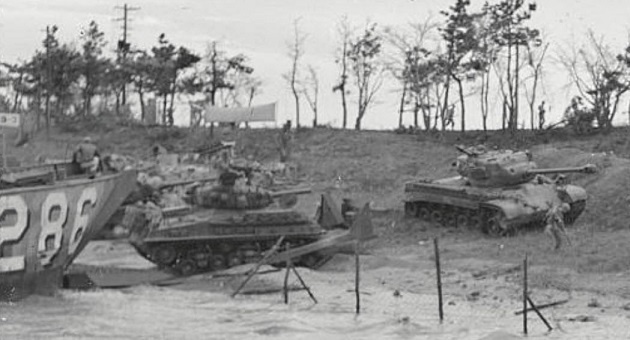
View of LSU-1286 and LSU-1080 unloading on the beach of Wolmi-do island. In the foreground, marines are marching captured North Koreans down the hill.

My close up of the above photo shows the M26 is number 31.

The M26s cut across the island supporting the Marines in cleaning up NKPA resistance.
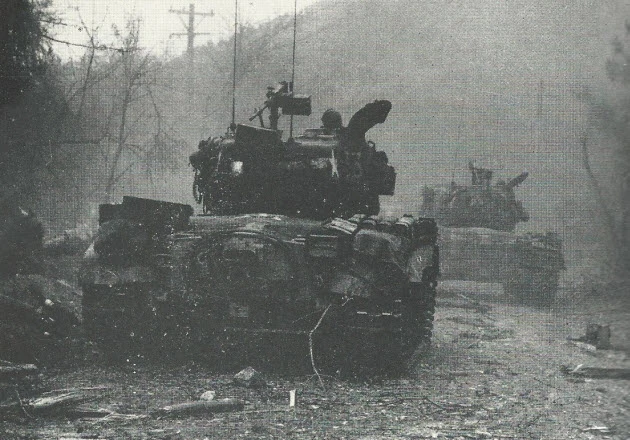
In this view, barely visible is number 33 on the nearest M26 turret.

A tank-infantry patrol of Company G assaulted and took So Wolmi-do, an islet dangling at the end of a causeway from Wolmi-do island. The number 2 on the turret indicates this is M26 is most likely number 32.
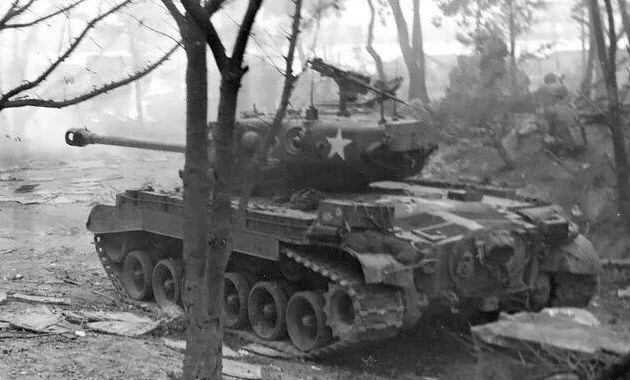
This photo is of the causeway with the port of Inchon in the background. Wolmi-do island was secured by 0800 hours and these marines are guarding the causeway while waiting for the tide to come back in and the final assault on Inchon. At 1730 hours, the 1st and 2nd Battalions, 5th Marines landed at Red Beach scaling the sea wall with ladders and the 1st Marines landed at Blue Beach. Then the Marines and tanks on Wolmi-do crossed the causeway and joined the assault on the rest of Inchon.

A NKPA armored car (most likely a BA-64) happened to ventured out of the port along the causeway towards Wolmi-do island. Fullerton’s tank 34 zeroed in on it and destroyed it with one 90mm round. Some sources state a MAG-33 F4U-4B Corsair spotted the armored car on the causeway and destroyed it.
This is a view of Wolmi-do island after it was secured. There is a M26 tank on the right edge of the photo.
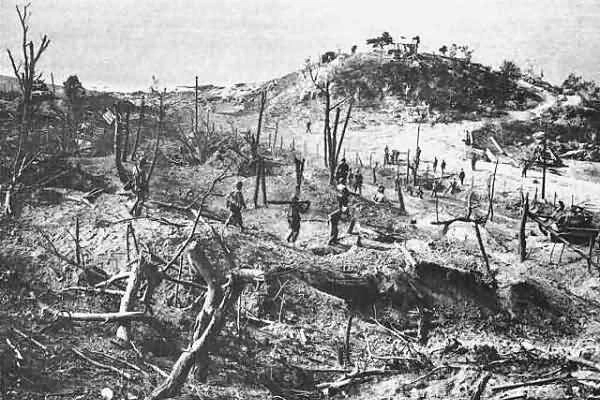
A M4A3(105) dozer tank on Green Beach on September 16. A number of NKPA soldiers in caves on the island refused to surrender to the Marines. The dozer tanks sealed up the cave entrances with earth. Note the dozer tank is number 43 and has track links on the hull side for additional protection against anti-tank fire.

This is Wolmi-do island today with a Theme Park on the west side of the island. Note how the surrounding area has built up over the 69+ years.
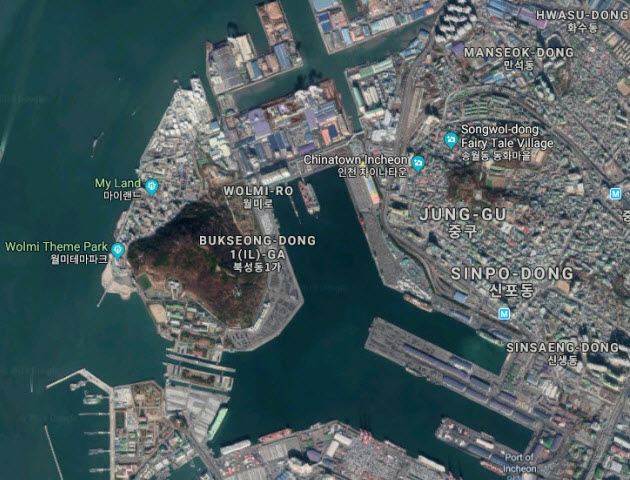
The successful Inchon landings severed the North Korean supply lines to their units in the south. The NKPA divisions surrounding Pusan began to weaken and retreated north. The UN forces broke out of the Pusan Perimeter and pursued the retreating NKPA units north.
This photo is in the USN archives and the name of the marine posing next to tank 33 is unknown. This marine is probably Swinicke.
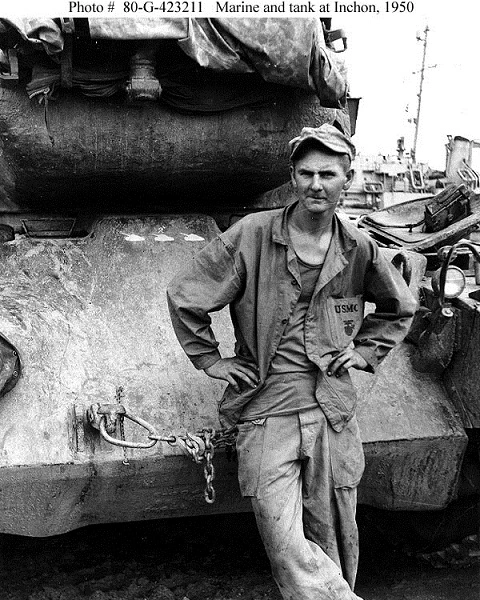
This is my close up of the three kill markings on the M26 number 33. Note the number 2 painted above the center T-34 marking. It might indicate that tank 33 helped destroy two of the three T-34s in the engagement on August 17 making it two half kills. Then tank 34 would probably been credited with one kill and two half kills.
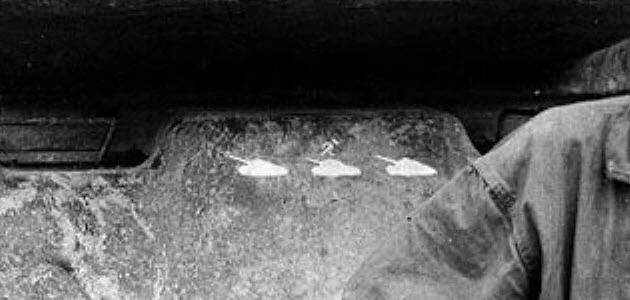
MAP: The advancement east of Inchon.

A M26 column leaving Inchon. The nearest M26 is kicking up dust and fumes.
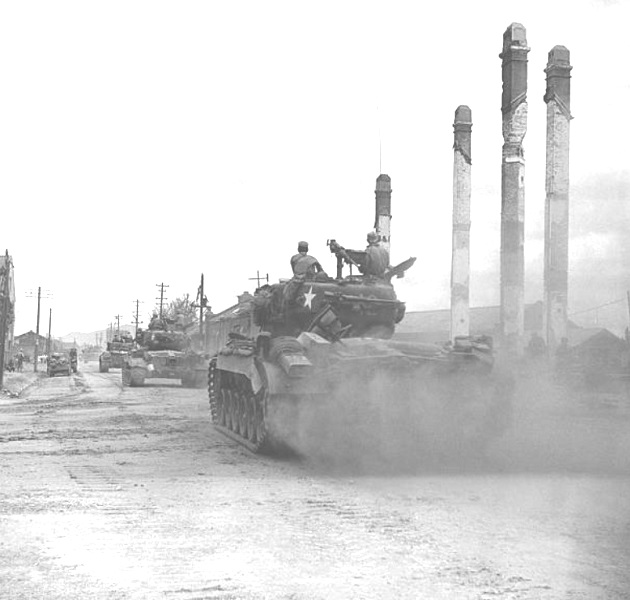
M26 number 33 on the road accompanying columns of marching marines. Note the white star painted on the engine deck.

On September 17, 2nd Battalion, 5th Marines held the hills overlooking the Inchon-Seoul Highway. In a defile was 2/5’s anti-tank unit and Marine tanks. At dawn, six T-34s with infantry riding and walking along side was advancing toward Ascom City. The North Koreans were unaware of the Marines and tanks. The Marines held their fire until all the T-34s were in their kill zone and then unleashed with everything. An assault man raced forward and set the lead T-34 on fire with his bazooka. He damaged the second T-34 as the Marine tanks opened up. Under the intense fire, the North Korean infantry fell from their tanks only to be run over. All six of the T-34s were destroyed and 200 North Koreans were KIA. One Marine was wounded. During the mop up, a column of jeeps drove up with Generals MacArthur, Shepard and Smith wanting to inspect the ambush site. There are several well known photos of MacArthur looking over a destroyed T-34. VMF-214 F4U-4B Corsairs also claimed spotting and destroying six T-34s with Napalm in that area on September 16.
This T-34 was destroyed in the ambush. Note the two shell hits on the front hull.
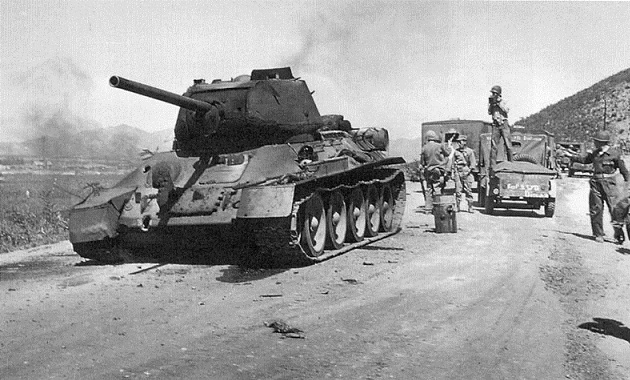

On September 18, the 5th Marines supported by A Company M26s captured Kimpo airfield. Note the destroyed North Korean plane in the background. The 5th Marines captured one Yakovlev Yak-9P and two Ilyushin IL-10Ms intact and they were sent to the USA for evaluation. The airfield with its 6000 foot runway was the largest in Korea and later became a major UN air base.
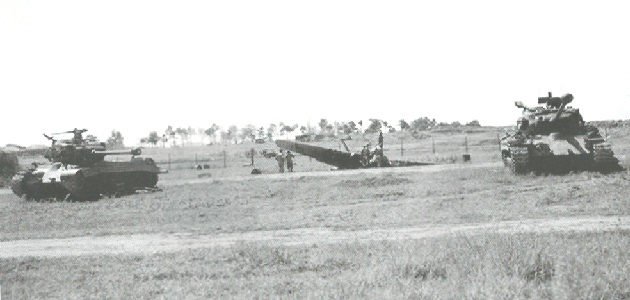
M26 number C-25 and other tanks on a road heading towards Yongdungpo firing at enemy targets. It has T80E1 steel chevron tracks and there are ejected shell casings on the road. Note the canteens and mess kit cups hanging on the rear of the turret and USMC camouflage shelter half rolls on the rear deck.

T26E3 testing revealed that the thin sheet metal fenders tended to droop and foul the tracks. Turnbuckles and rod supports were added to fenders to help keep them straight. These supports were not fitted to the T26E3s that were deployed to Germany in 1945 but were added later. All the M26s in Korea had them fitted along with the field telephone box on the rear hull.

A squad of leathernecks riding on M26 number B41 during the advance to Seoul.
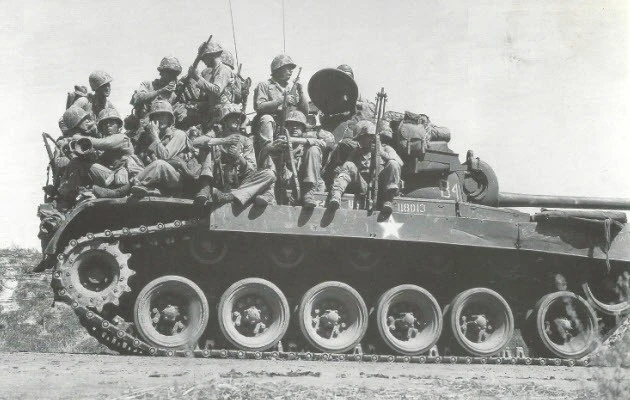
Another view of M26 number B41 advancing down a road. Note the Marines resting on the side of the road.
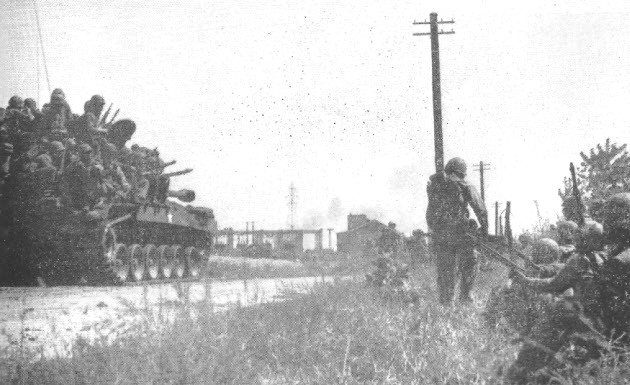
M26 of the 4th platoon commander, Company B during a break in the fighting on September 19. The location is probably somewhere near or in Yongdungpo.

M26 number B25 driving through the outskirts of Seoul, probably Yongdungpo.
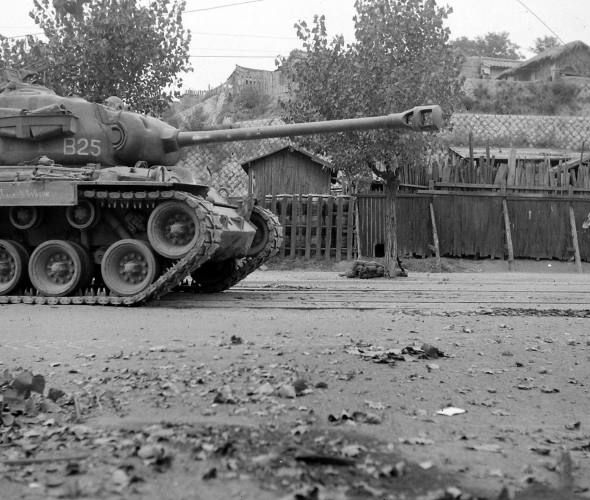
BATTLE FOR SEOUL, September 25-27
Also known as the Battle of the Barricades was heavy street fighting which involved forcibly uprooting defending NKPA troops from either roadblock barricades or isolated strongpoints within or atop of buildings. It required engineers, tanks and infantry to clear the barricades (often supported by artillery or air strikes) and rifle squads supported by rocket launchers and scout snipers against the strongpoints. The Marines found one particularly deadly NKPA outpost contained a US Browning .50 Caliber heavy machine gun which was captured during the first weeks of the war. All the major avenues, thoroughfares and each significant intersection in the city had an improvised barricade of burlap bags filled with sand, dirt, rubble or rice piled about eight feet high and about five feet wide. Some included pieces of furniture or wood in the construction. They were defended by 45mm AT guns, heavy machine guns and mines. NKPA troops also lobbed Molotov cocktails from the rooftops onto the Marine tanks in the streets below. Each position took the Marines an average of 45 to 60 minutes to overcome.
M26 number B32 in action on a street in Seoul. Ejected shell casings on the street indicate that the main gun probably was fired. The smoke in front of the tank is from the front hull .30 Caliber machine gun firing at NKPA troops. Note the number B32 is painted in two places on the turret side.
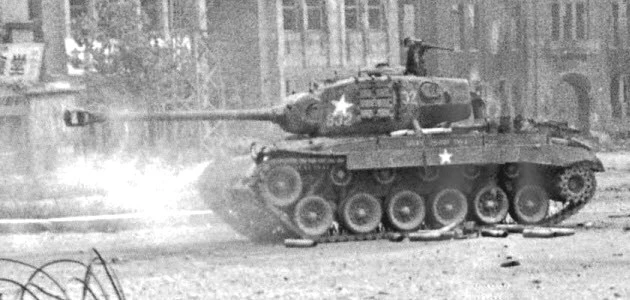
M26 number B22 approaching a NKPA barriade in Seoul.

M26 number B23 passing through a NKPA barriade. Note the wooden gate fence pushed aside.
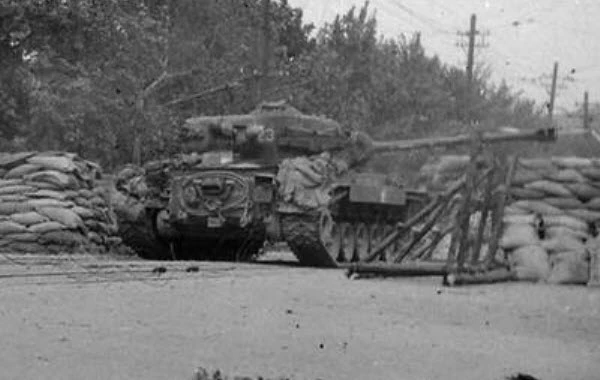
A M26 advancing through a NKPA barriade. The name “DEAD EYE DICK” is painted on the side fender around the small white star. A Marine sniper team waits for the 45mm AT fire to abate before moving into a new firing position.
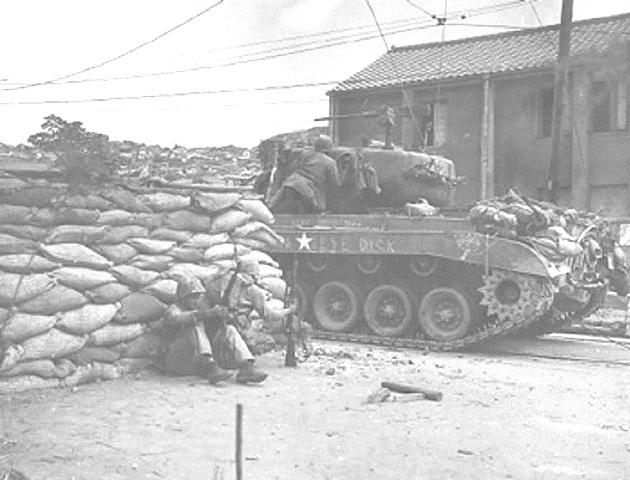
This is a view down a street in Seoul. The M26 and M4A3(105) dozer tank in the foreground are covering a tank passing through a barricade at the far end of the street.

Film: Marines and US seventh division recapture Seoul
Film: Korean War battle of Seoul US Army M26 Persing Tank
WONSAN, Operation Yo-Yo
After the successful landing at Inchon, General MacArthur ordered a series of amphibious landings along the east coast of Korea to outflank the North Koreans. The 1st Marine Division would board ships at Inchon for the target landing at the port of Wonsan with D-Day being October 15. The US 7th Infantry Division would proceed south to Pusan to board ships for a subsequent landing north of Wonsan. While the Inchon landings stand as a masterpiece, the Wonsan landing was a laughing stock, the most ill-conceived landing the US ever conducted. At that time, the medium capacity ports at Inchon and Pusan were offloading mammoth amount of supplies for the US 8th Army while simultaneously loading two large divisions for the Wonsan landings. The piers, staging areas, and access roads in both ports become extremely congested which caused many delays. The loading of the 1st Marine Division was completed on October 15 but a series of other events made the planned assault meaningless. Five days earlier, units of the ROK I Corps advanced overland from the south and already seized Wonsan and the surrounding area. On October 13, planes
of MAG-12 squadron VMF-312 flew to Wonsan airfield. Then it was discovered that the North Koreans had sewn the sea approaches to Wonsan with 2000+ sea mines of the contact and magnetic types. The US Navy only had 12 minesweepers available in Korea compared to the 100 employed at Okinawa 5 years earlier. Even with Korean and Japanese ships, the job was overwhelming and a number of minesweepers hit mines and were sunk. Heavy fire from North Korean coastal guns also hampered operations. The embarked Marine task force finally got underway on October 19 and for the next week the ships reversed course every 12 hours, first heading south, then north and then started over repeatly. That was when the nickname “Operation Yo-Yo” emerged. Finally, on October 26, the 1st Marine Division landed on the Kalma Peninsula below Wonsan which was the most anticlimactic landing the US Marines
had ever made (up to that time).

A M26 of 2nd Platoon, D company with its wading gear still attached parked beside the Wonsan airfield on October 27. This was the only time M26s employed wading trunks for an amphibious landing. In the background is an USMC Douglas C-54 Skymaster.

Caption stated that a M46 tank is exiting from LST-914 at Wonsan on November 2. Do not assume that photo captions are always completely accurate.
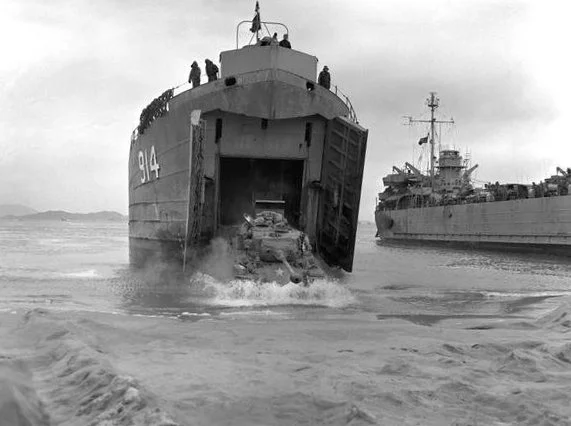
This is my close up of the tank in the above photo. The gun barrel clearly shows that this is a M26. Note the tactical number “B41”.
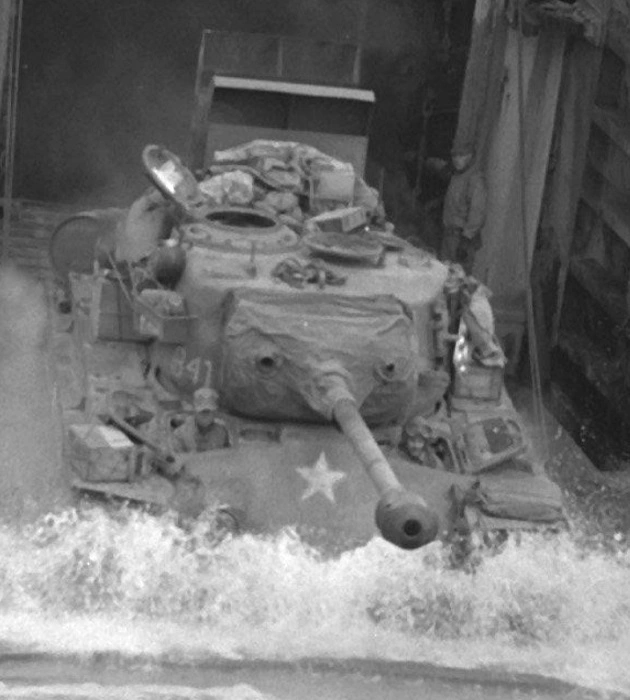
A Marine M4A3(105) dozer tank exiting a LST.
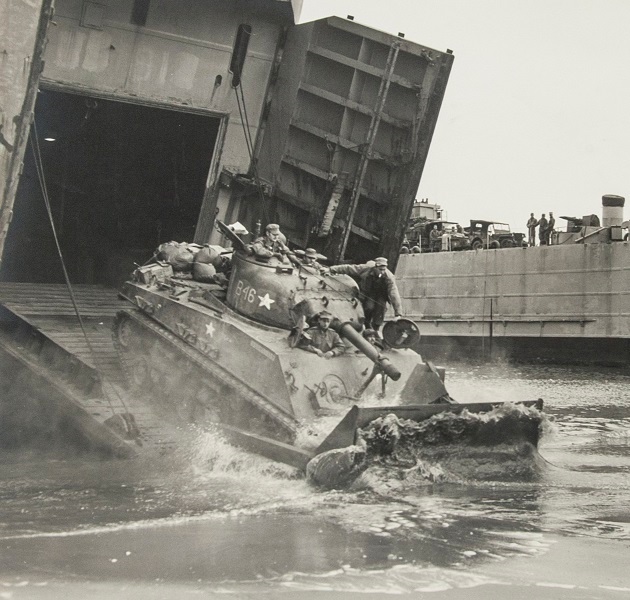
Chosin Reservoir and Withdrawal
After the 1st Marine Division landed at Wonsan, the division advanced north along the coast to Hamhung. The main objective of the Marine force was the Chosin (Changjin) Reservoir because that was the area of the main North Korean hydroelectric power system.
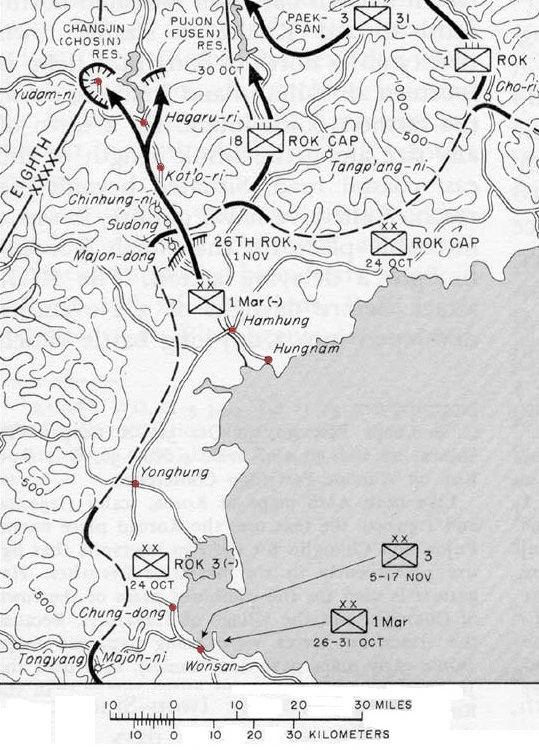
A M26A1 near Hamhung (north of Wonsan) on November 10. Around this time, some Marine units began to paint the tank tactical number on the mantlet.

A M32A1B3 ARV in operations near Hamhung on November 10. It was usual practice to allot at least one of M32 ARV to each Marine tank company.
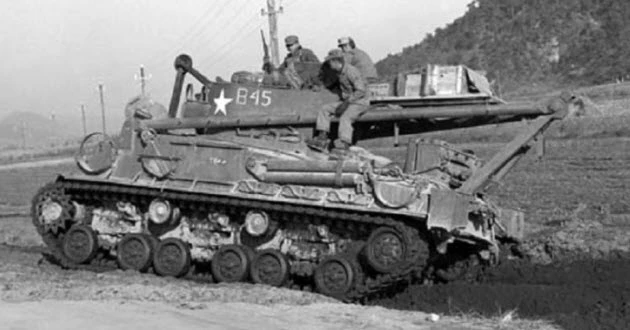
On November 1, China had entered the war where troops of the 115th and 116th Divisions crossed the border into Korea and attacked ROK and US Army units resulting in halting the forward advance of the UN forces. The ROK and US Army units began to retreat. On November 25-26, the Chinese Volunteer Army had been reinforced by the IX Army Group increasing the Chinese forces in Korea to 31 Infantry Divisions. Seven Chinese Divisions surrounded the 1st Marine Division in the Chosin Reservoir area and the Division was ordered to withdraw to the port of Hungnam to be evacuated along with other UN forces back to Pusan. Press correspondents asked the commanding Marine general if he intended to retreat. They quoted him as giving the immediate historic reply: “Retreat hell! We’re just attacking in another direction.”
M26 number 33 and another tank of Company A passing a destroyed truck on the side of the road. The unit codes on the truck’s bumper indicates it belonged to the 7th Recon Company of the US 7th Infantry Division. The date and location of this photo is unknown but the US 7th Infantry Division did linked up with the Marines near Hagaru-ri during the withdrawal and the tank crew is wearing cold weather clothing.
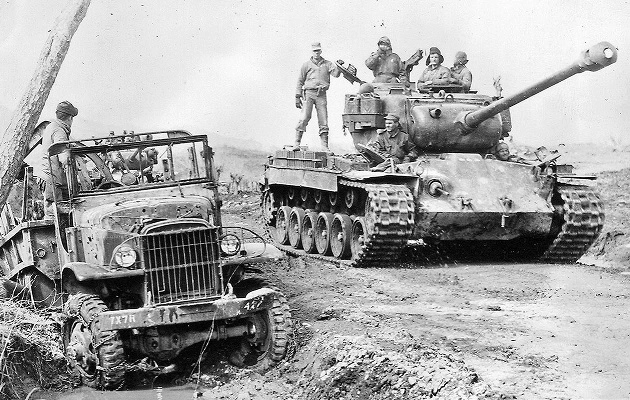
On December 6, the 5th and 7th Marines were surrounded by Chinese forces near the Chosin Reservoir and they began an attack southward to break out. This column of M26A1s supported the advance down the road south from Hagaru-ri.

First Marine Division took to the road on withdrawal from Kot’o-ri on December 8. By December 9, the Marines had crossed the Kot’o-ri bridge through the Funchilin Pass. The Pershing tanks were used as rearguards as it was feared their weight would had damage or collapse the bridges. During the advance south, the Marines lost 5 tanks to Chinese anti-tank fire. It does look very cold, brrrr.

This is my close up of the above photo. The Tactical number appears to be either B24 or D24. The mantlet is covered and the muzzle break appears to be double baffled as on the M26.

The 1st Marine Division, as it came into Hungnam from the Chosin Reservoir on December 11, assembled between the port and Yonpo Airfield. The division loaded over the following three days and sailed for Pusan at mid-morning on December 15.
Film: With The Marines – Chosin To Hungnam (1951)
Film: 12/11/1950, Remnants Of 5th & 7th Regiments
Hollywood Movie: Retreat, Hell!!, 1952
Stars: Frank Lovejoy, Richard Carlson, Anita Louise
REFERENCES
US TANKS VISUAL DIFFERENCES
M26
- 90mm M3 gun with double baffle muzzle brake and no bore exacuator.
- Engine exhaust pipes mounted on the rear hull and no Tension Idler Wheel.
M26A1
- 90mm M3A1 gun with single baffle muzzle brake and bore exacuator.
- Engine exhaust pipes mounted on the rear hull and no Tension Idler Wheel.
M46
- 90mm M3A1 gun with single baffle muzzle brake and bore exacuator.
- New engine with muffler and exhaust pipes mounted on side rear fenders.
- A Tension Idler Wheel was added between the last road wheel and the sprocket.
- A pioneer tool rack mounted on the front hull.
(The 1st Marine Tank Battalion began receiving the M46 in 1951.)
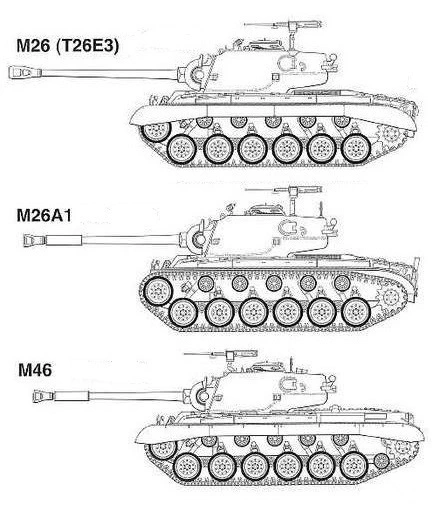
Marines are examining captured NKPA infantry weapons. In the foreground is a Maxim’s machine gun model 1910 on a wheeled Sokolov’s mount. Behind it is a Soviet 45mm Model 1942 anti-tank gun which was derived from the same Rheinmetall 37mm anti-tank gun used by the Germans in WWII. The barrel was thickened and lengthened for better anti-armor performance. It could not penetrate the frontal armor of the M26 or M46 but the North Koreans often positioned these guns near the base of ridges or hills and gut-shot the US tanks when their thinner belly armor was exposed as they went over the top.
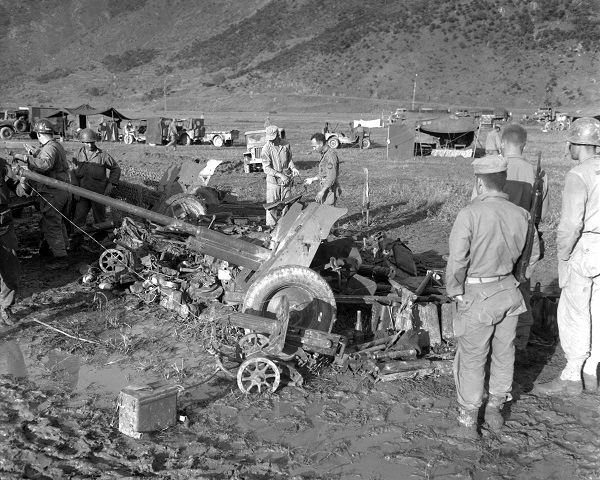
MAP OF KOREA 1950

MODEL KITS AND ACCESSORIES
Dragon 6801 1/35 M26A-1 Pershing – 1994
Dragon 6032 1/35 T-26E3 Heavy Tank – 1995
Tamiya 35254 1/35 M26 Pershing – 2002
Hobby Boss 82425 1/35 M26A1 Pershing Heavy Tank – 2009
Tamiya 32537 1/48 M26 Pershing – 2005
Trumpeter 07264 1:72 US M26 (T26E3) Pershing Heavy Tank – 2008
Trumpeter 07286 1:72 US M26A1 Pershing Heavy Tank – 2008
Black Dog US M26 Pershing accessories sets:
No. T35060 – 1/35
No. T48044 – 1/48
No. T72099 – 1/72
Peddinghaus Decal Sheets:
1/35 M26 Pershing Tank Markings Germany WWII & Korea (6 tanks) 1040
1/72 M26 Pershing Tank Markings Germany WWII & Korea (6 tanks) 1041
1/48 M26 Pershing Tank Markings Germany WWII & Korea (6 tanks) 3233
(M26 number “33” & “B41”)

Nice post, Mike!
LikeLike
Thanks, I’ve recently been searching for information about this subject matter for ages and yours is the best I have located so far.
LikeLike
Awesome post as usual! It answered my question regarding what the tactical numbers on the turrets meant. Hopefully I can remember it means company, platoon, tank in that order lol. A quick question: was that order specific to the Marine Corps or did Army tanks also paint tactical numbers via company, platoon, tank?
LikeLike
Wow that was strange. I just wrote an very long comment but after I clicked submit my comment didn’t show up. Grrrr… well I’m not writing all that over again. Anyways, just wanted to say superb blog!
LikeLike
Its like you read my mind! You seem to know a lot about this, like you wrote the book in it or something. I think that you can do with some pics to drive the message home a little bit, but other than that, this is excellent blog. An excellent read. I’ll definitely be back.
LikeLike
My father is a 1st Marine, 1st Tank Battalion, Dog Company who arrived in Korea in February or March 1951. You’ve posted the most I’ve ever seen on his company in Korea. Is there a way to contact you directly?
LikeLike
Thank you so much for researching and posting this!
My name is Craig Fullerton and my father is Gsgt. Cecil Fullerton who commanded tank A34 and was one of the two tanks to knock out the T34s at Obong-Ni Ridge. He is 92 years old and still kicking … one of only 3 or 4 guys still left from A Company. I printed this out for him and he absolutely loved it! We had seen most of the pics … but had NEVER seen the pic of him on the way to Wolmi-Do Island at Inchon. Once again, thank you from both of us!
LikeLike
Thank you for documenting this information. My dad passed away 13 years ago, and I never knew much about his experiences in Korea. I recently came across records indicating he arrived in Pusan 2Aug50, Inchon 15Sep50, and then worked his way up to Chosin where he appears to have disembarked Hungnam 12Dec50 with injuries likely due to frostbite. Based on his Record of Service, he was with 75mmRecGunCo, 5th MarRein 1swt ProvMarBrigRein FMF as of 31Jul50 and transferred to Anti-Tank Co 5th Marines, 1stMarDiv, FMF 20Dec50. I would love to hear of any sources you may have come across that have Muster Rolls that my help me follow his path closer during this time. Thanks again for posting this information!
LikeLike
Mike, I’m sure I know who one of the Marines are in the photo of” tank number 14″ as they chow-down next to their tank. The Marine sitting in the chair on the right with a long flat is, LT. M.S. Ashcraft, I believe.
LikeLike
By the way, just a small correction (from my Dad):
BOTH tanks – A33 (Swinicke) and A34 (my Dad’s, Fullerton) had the three tanks painted on the front indicating their “kills” on Obong-Ni Ridge.
The tank in the photo passing the recon truck (Marines in cold weather gear) is clearly my father’s A34. He is unmistakable sitting in the turret.
LikeLike
Putting a photo album together for a reunion may I use some of your photos? I was a marine corp tanker in 3rd, 1st, and 4th tanks. I was also in 1st track vehicle bn Japan.
LikeLike
I have photos taken by my father of USMC M26’s in Korea if you like to add them to the blog. I also have a photo of a destroyed M4E8 in Korea. …and AMTRAK photos.
LikeLike
I am researching Marine tank battalions in Korea. I keep coming up with 1st Tank Battalion but this seems to have been staffed by reserves and soldiers already at Pendelton. I am trying to find what tank battalion might have been staffed by marines that signed up in WWII but didn’t finish their tour of duty. May have been infantry that switched to tank. This research is for a book of fiction I am writing but want my information to be accurate on the Marine character who served. Many thanks for any information you can provide.
LikeLike
Very enjoyable and informative read. Came in real handy while building Tamiya’s M26 Pershing B41. My only question is, how accurate is the Tamiya kit in regards to construction and decal placement for tank #B41. I’ve seen pics of B41 with partial side skirt on the right side and none on the left.
LikeLike